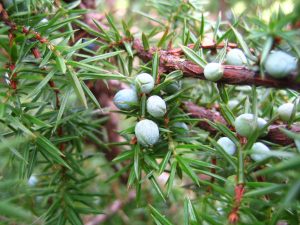Juniper – Juniperus communis (Cupressaceae)
Gaelic: aiteann
Juniper is a shrubby conifer, with a wide range throughout the cooler regions of the northern hemisphere. It can have quite a variable form, which can be dependent on the environment in which it is growing, with the form of some changing when in cultivation. In Scotland two forms are recognised; Juniper communis subspecies nana, which has a low ground hugging form and occurs on high mountain tops. The second is Juniper communis subspecies communis, which has a taller more bushy form and forms part of the understorey in old pine woods. The leaves are needle-like with a grey-white band on the upper and lower surfaces. Juniper is wind pollinated and male and female reproductive cones occur on separate plants (dioecious). The female cones are round and berry like; these are initially green, ripening to blueish-black.
Juniper wood isn’t widely used, as it is considered too small for most tasks, although it is used to make small containers and decorative items in some countries. The wood burns well, so was popular for use in small kilns; the lack of smoke it produces meant it was a popular choice for heating illicit whisky stills, as it reduced the chances of discovery by excisemen. The female cones are also known as juniper berries, these can be dried and used as flavouring in sauces and stuffing for strongly flavoured meat e.g. game. The berries are also one of the main botanicals used for flavouring gin and they are used to flavour beer.
Juniper was believed to have the power to protect from evil, and so it was often used as a charm and would be burnt and the smoke allowed to fill the house in order to purify it.
Location


2 Comments
2 Pingbacks